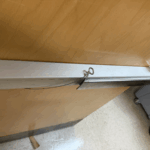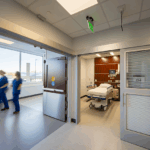 After last week’s post about a change to the 2021 International Building Code (IBC) which requires automatic operators on some public entrances, I received a few questions. This is a pretty major change, since the previous codes and standards did not require auto operators as long as the doors could meet the requirements for manually-operated doors. Here is one of the questions:
After last week’s post about a change to the 2021 International Building Code (IBC) which requires automatic operators on some public entrances, I received a few questions. This is a pretty major change, since the previous codes and standards did not require auto operators as long as the doors could meet the requirements for manually-operated doors. Here is one of the questions:
What types of buildings fall into the use groups where automatic operators are required for public entrances?
In last week’s post, I included the table from the 2021 IBC that lists the applicable use groups and occupant loads for buildings that will be required to have at least 1 door or 1 set of doors (exterior and vestibule) with automatic operators on their public entrances. The change applies to almost all types of assembly occupancies with an occupant load of 300 people or more, and for business, mercantile, and R-1 residential occupancies with an occupant load of 500 people or more. There were some questions about the use groups, so here’s a breakdown. The examples listed with each use group are not intended to be inclusive of every type of facility.
Occupant Load 300+
- A-1 – assembly occupancy, usually with fixed seating, used for production and viewing of the performing arts or movies, including movie theaters and other types of theaters, symphony and concert halls, and TV and radio studios that admit an audience
- A-2 – assembly occupancy used for food/drink consumption, including banquet halls, gaming areas of casinos, nightclubs, taverns, and bars, restaurants, cafeterias, and similar dining facilities (including associated commercial kitchens)
- A-3 – assembly occupancy used for worship, recreation, or amusement and other assembly uses not classified as another Group A use group, including arcades, art galleries, bowling alleys, community halls, courtrooms, dance halls (without food or drink consumption), funeral parlors, lecture halls, libraries, museums, places of religious worship, waiting areas in transportation terminals, and gymnasiums, indoor swimming pools, and indoor tennis courts without spectator seating
- A-4 – assembly occupancy used for viewing of indoor sporting events and activities with spectator seating, including arenas, skating rinks, swimming pools, and tennis courts
- Note: Group A-5 is not included in the table that requires automatic operators at the public entrances, but I don’t like leaving loose ends, so Group A-5 is an assembly occupancy used for participation in or viewing outdoor activities, including amusement park structures, bleachers, grandstands, and stadiums (the auto operator requirement does not apply here).
Occupant Load 500+
- B – business occupancy used for office, professional, or service-type transactions, including ambulatory care facilities, doctors, dentists, and veterinarian offices, banks, beauty salons, outpatient clinics and ambulatory care facilities, labs, post offices, and educational occupancies for students above the 12th grade (colleges and universities)
- M – mercantile occupancy used for display and sale of merchandise including merchandise stock, where the public has access, including retail stores and markets, greenhouses providing public access for the display and sale of plants, and motor-fuel dispensing facilities
- R-1 – residential occupancy containing sleeping units where the residents are primarily transient in nature, including hotels and motels, and congregate living facilities and boarding houses with more than 10 occupants (all transient)
Remember, the auto operator requirement applies if a) the project is required to comply with the 2021 IBC, b) the entrance is a public entrance that is required to be accessible, c) the use group is one of the types listed above, AND d) the calculated occupant load is greater than 300 or greater than 500, depending on the use group. The operators are required for 1 door or 1 set of doors (exterior and vestibule) at each public entrance – not every door at each public entrance.
If you’d like to practice the basic use groups, there are some Quizlet cards here, and if you need to calculate the occupant load, that is covered in this Decoded article.
You need to login or register to bookmark/favorite this content.





My bigger question was, why are they limiting the occupancy types, or maybe more correctly, why are they focusing only on these? I would argue I occupancies need them more, and I find them common on E occupancies as well.
I agree, Todd…there are plenty of locations that would benefit from an automatic operator. I’m guessing that if the code change proposal had required operators in more locations, it may have gotten some push-back on the basis of financial burden and may not have passed. Here is the reason statement from the code change proposal, which gives some background on the intent behind it:
Reason:
1. Enhances accessibility. It is widely accepted that automatic doors in general enhance overall accessibility, by accommodating a wide array of conditions people have that qualify them to need accessibility at facility entrances. This accommodates a wide variety of accessibility needs that manual doors being installed today cannot encompass.
2. Considers “transient” use. The Table directly addresses people who infrequently use public entrances so that they would need no special knowledge, skill or tool to enter a facility. All occupancies included in the Table experience such “transient” use.
3. Addresses a public need. The occupancies cited are associated with a serious existing need for automatic doors. The safety of both use and moving people in and out of buildings in those occupancies by using only manually operated doors is a major concern particularly in emergency situations.
4. Focuses on public entrances. The Table applies where the public is most likely to access facilities. Regarding which public entrance to choose for an automatic door if multiple entrances are accessible, this is left to the building designer on which would be best but the requirement of “at least one” door allows the designer to consider all
entrances if feasible.
5. Occupancies involved are those most applicable to the public. The population requiring accessibility commonly needs accommodations to enter assembly, business, mercantile, and hotel/motel facilities as part of their everyday life. No code requirement for automatic doors means an increased safety risk and a decreased accessibility convenience.
6. Brings completion to accessible entrance provisions. The Table is needed in Section 1105, where accessible entrances are governed.
7. No disproportional economic burden. The thresholds have been chosen so as not to be a requirement for smaller occupancies such as small assembly facilities or strip mall businesses.
8. Addresses statistical need for accessibility. The thresholds also assume that a minimum of 2% of the population will be in need of accessibility at any given time for the specified occupancies. For an occupant load of 300, this means that at least six people will have the need that an automatic door will provide. The anticipated accessibility need should exceed this estimate a large enough percentage of time to constitute a critical mass of facilities needing power-operated doors when meeting the established thresholds.
9. Enhances public safety. Automatic doors are regulated by ANSI/BHMA safety standards intended to prevent people from coming in contact with moving doors. Facilities employing automatic doors are required to abide by these requirements, which affords protection to anyone – including children, the elderly, and/or those with accessibility need – in the vicinity of moving doors while minimizing or preventing operational problems. Automatic doors are thus far safer in the marketplace than manually operated doors.
10. Favorably increases facility usage. Those with accessibility needs are less likely to choose to use a facility without an automatic door, therefore resulting in reduced institutional, social, and economic benefits to entities operating within a facility.
11. Occupant load thresholds have related code precedence. The justification of minimum occupant load uses Risk Category and minimum number of exits as starting points, since these are the only locations in the Code with occupancy thresholds to consider. Risk Category and minimum number of exits share a common concern with automatic doors because the threshold numbers represent a critical mass of people above which a unique set of code requirements need to apply. Following is an explanation of how the threshold numbers have been arrived at for each occupancy in the Table.
o Group A: Also from Table 1604.5, Risk Category III. The scope of public assemblies is an occupant load greater than 300.
o Groups B, M and R-1: From Table 1006.3.1, minimum number of exits or access to exits per story. Table 1006.3.1 states that three exits or exit access doorways shall be provided from any space with an occupant load of 501 to 1000, and four shall be provided with an occupant load greater than 1000. The proposed Table would set a threshold
of three exits or exit access doorways, in a given story with a public entrance, to require an automatic door at that public entrance. R-1 is the applicable Group R occupancy because hotels and motels should be encompassed by the Table where the threshold occupant load would be appropriate for those structures.
12. Alleviates concerns about maximum manual force required to operate an entrance door. Although the IBC regulates this maximum force, any type of force needed to operate a manual door is a concern for the accessibility community. Automatic doors would require no force to operate.
13. Alleviates concerns about manual force variations. Wind pressures, internal building stack pressures, and/or increasing hardware friction are common concerns and affect manual operation of entrance doors all throughout the country. This concern is removed since automatic doors require no force to operate.
14. More than a “best practice” requirement. The requirement is a need, as opposed to a “best practice”, because automatic doors encourage people to use facilities, are safer, and more efficiently move people in and out of buildings. It is widely known that people – particularly children, the elderly, and/or those with accessibility needs – have great difficulty, or find it impossible, to open entrance doors because of stack pressures, door configurations, door friction, wind, or door weight.
– Lori